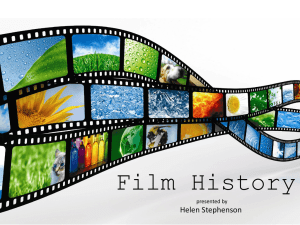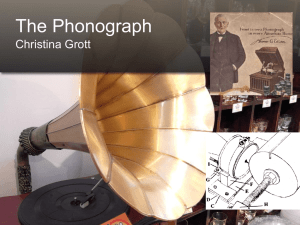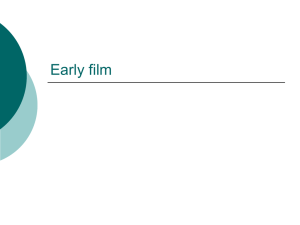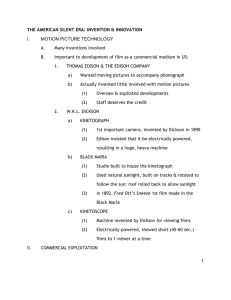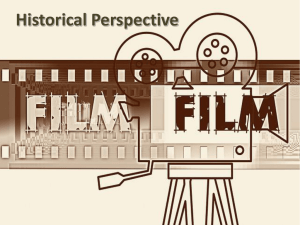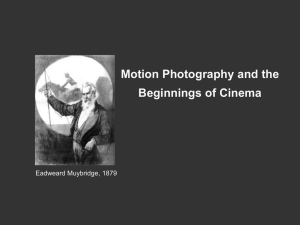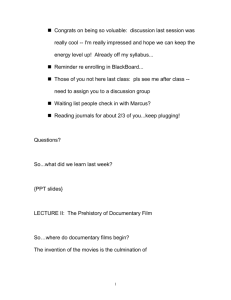c. The Prehistory of..
advertisement
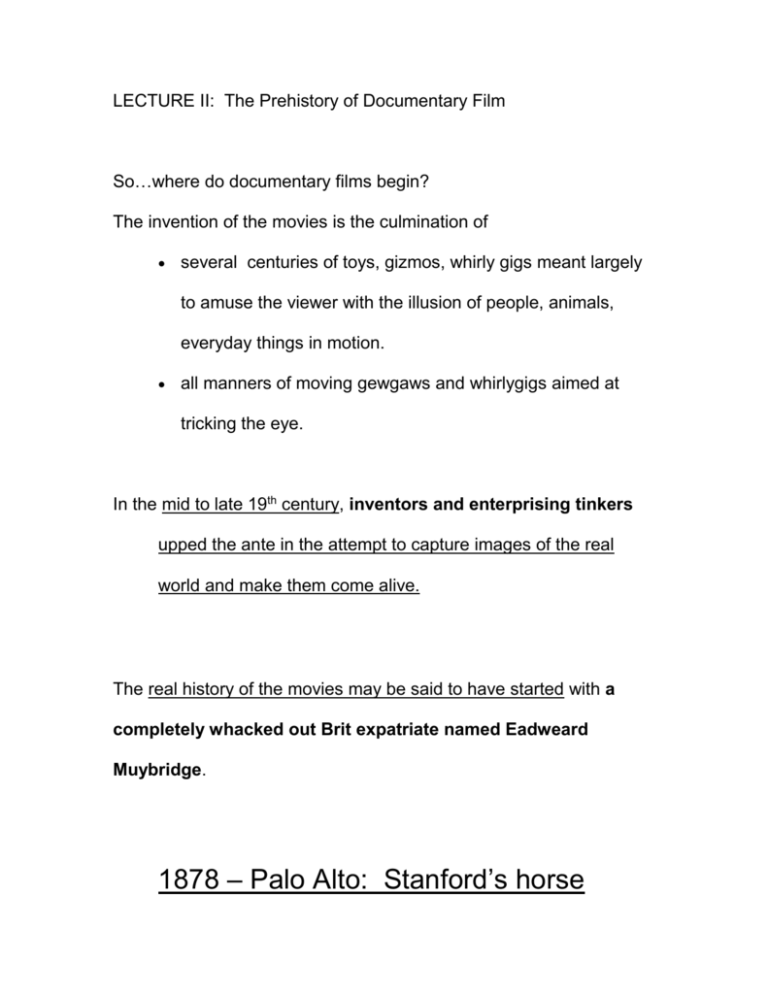
LECTURE II: The Prehistory of Documentary Film So…where do documentary films begin? The invention of the movies is the culmination of several centuries of toys, gizmos, whirly gigs meant largely to amuse the viewer with the illusion of people, animals, everyday things in motion. all manners of moving gewgaws and whirlygigs aimed at tricking the eye. In the mid to late 19th century, inventors and enterprising tinkers upped the ante in the attempt to capture images of the real world and make them come alive. The real history of the movies may be said to have started with a completely whacked out Brit expatriate named Eadweard Muybridge. 1878 – Palo Alto: Stanford’s horse Persistence of vision SHOW DOG Thomas Edison. William Dickson A year before Muybridge's experiments in Palo Alto, Edison unveiled another, perhaps more startling invention--the phonograph. Edison had met with both Muybridge in the late 1880's…the potential of "moving pictures" whetted his inventor and businessman's appetite. In an attempt to protect his future, he filed a patent on October 17, 1888, describing his ideas for a device that would "do for the eye what the phonograph does for the ear.". He called it a "Kinetoscope," using the Greek words "kineto" meaning "movement" and "scopos" meaning "to watch." Although the project interested Edison, his main interest in the invention seems to have been to provide visual accompanyment to his phonograph. Edison's motion picture had more than a few shortcoming Edison's camera was a monsterously huge contraption…the camera--which had to remain fixed due to its size and weight--was situated in a kind of rambling lean-to studio in West Orange New Jersey, which was nick-named THE BLACK MARIA. Filming was dependent on natural sunlight and the subjects of the film had to be brought in front of the camera, filmed at a fixed distance from the camera against a dark backdrop, devoid of context. Edison's earliest films were not projected for audiences at all…: they were initially produced and marketed as a single-viewer peep show … carnivals, midways, nickelodeons… In general, Edison showed only passing interest in the invention…at least not early on.. The real breakthroughs were happening across the Atlantic in France. SHOW DAWN OF THE EYE CLIP Audiences were dumbfounded... This most definitely was NOT the kind of theatrical spectacle most audiences of the day were used to…these were images that captured life and hurled them at the audience. When a similar showing was held the following year that featured a a moving image of a train entering the railroad station in the town of Ciotat, members of the audience reportedly cowered in fear, ran for the back of the café, or fled into the street in terror. Maxim Gorky reporting on the exhibition: "Last nite I was in the kingdom of shadows - it is terrifying to see, but it is the movement of shadows. Suddenly something clicks, everything vanishes and a train appears on the screen. It speeds straight at you -- Watch out! It seems as though it will plunge into the darkness in which you sit, turning you into a ripped sack of lacerated flesh and broken fragments this hall and building, so full of women, wine, music, and vice. Discuss: Does this huge cognitive revolution have any counterpart today…? Is anything as transformative human perception and culture? Can anyone raised in the past century put yourself in the place of these first movie audiences? Or are we too worked over… What part of the experience would fascinate you the most? Unlike Edisons elephant of a camera, Lumiere's camera, which he called the "Cinematographe" weighed only 16 lbs-- less than 1/100th the weight of the Edison camera. It was powered by a hand-crank (unlike edison's electrically-driven contraption) and could easily be carried into the streets. Just as significant was the fact that the camera not only shoot the filmed but also developed and projected it--unlike Edison's peep show… If you were the inventor of the first portable camera…with no film vocabulary, no movie-going and little movie-making experience, What would you film? How would you film it? What do home movie enthusiasts film? The Lumieres and other early filmmakers inevitably turned to one of several subjects: perhaps the most common was life on the street. Both brothers rejected the theatre as a model for motion pictures. Instead, their express interest was in capturing "Vie sur le vif" -- life being lived…early films did just that: babies being fed; trains coming and going; workmen working, workers leaving a factory. The Lumieres their called short pieces (usually no longer than a minute) ACTUALITIES… The Lumieres, Edison, other citizens of the late 19th century, had certainly been exposed to prevailing trends in the arts. One of movement which had currency at this time in both literature and visual arts was -- Realism. Realism attempted to create objective representation of the world based on impartial observation of contemporary life… it sought to portray both the surface look of a subject and the psychological underpinnings beneath this surface. Realism was consciously democratic, including in its subjectmatter and audience activities and social classes previously considered unworthy of representation in high art This artistic trend toward recording the visible facts of everyday life, combined with the newness and technological limits of the new moving picture medium, undoubtedly shaped the subject matter of the Lumieres earliest films. The notion that film could be shaped and used to tell a story or to create a narrative would be a good twenty years in coming. ................ If these were perfectly ordinary things--things that could be seen everyday on the street--what were early audiences reacting to so enthusiastically… ??? fidelity of the images to their subject (even more so than photography and certainly more so than painting): direct evidence of what the camera saw… The novelty of motion itself held the audience in thrall A fascination with the surface look of the world. The voice of the filmmaker--the filmmakers point of view, shaping of the images--didn't have to be present to enthrall audiences at this point . These images seem to provide an unprecedented window into the real/historical world…a revelation and sense of seeing things previously obscured or at least overlooked. SHOW LUMIERE FIRST FILMS (62 min) Watch these very closely… QUESTIONS: Are these films really straight reportage…or do they bear glimmerings of a "voice" and style shaped by the filmmaker? Any glimmerings of feature films or narrative films? (i.e. film doing something more than reporting?)
